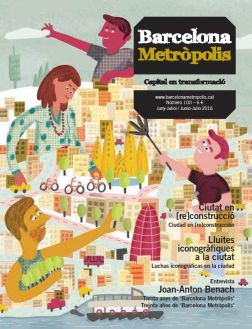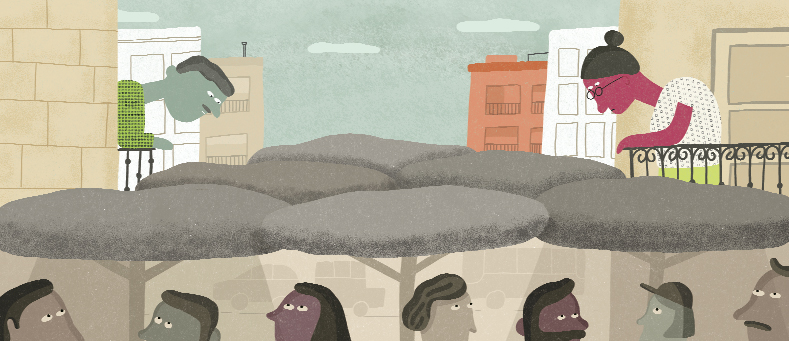There are large capitals (Rome, Paris and now New York – capitals of provincialism), there are cities of exceptional beauty (Venice) and there are cities with a special attraction (Marseille, Amsterdam, New Orleans). It’s as if the cities were people. Barcelona has been amongst those in the lattermost category. But if things carry on in the same direction, it will soon be removed from the list. Barcelona will then be a sad city, like a run-of-the-mill Dublin, without Joyce.
“Il n’est pas donné à tout le monde d’aller à Barcelone.”
1 SATURN SHADOW. Last summer I started a diary which included haiku-style writings about my amblings around Barcelona: observing the things I passed, seeing the city from the inside out. I wrote that one of the first things I noticed is that the end of the world is an endless succession of little ends of the world one after the other. You really notice it in August in Barcelona.
The haberdashery
has closed for the holidays
or, perhaps, forever?
I am offended and hurt by the systematic replacement of plane trees in the Eixample by hackberries. I don’t known whether they do it out of vice or greed, but plane trees are very important to our city: when the weather is hot, plane trees offer shade without blocking the light. The general population and artists love them. Els plàtans de Barcelona [The plane trees of Barcelona] is the title of a novel. “Plane trees along pavements add green to the air” (Vinyoli). “Clouds covered up the sun. The greenness of the plane trees, under the diffused light, took on a very special emerald hue” (Vila Casas). “The patience of L’Eixample’s plane trees. They teach me and keep me company” (Bauçà). I really like hackberries in squares or gardens (for example, the hackberry in the interior courtyard). However, two parallel rows of hackberries on a straight road as far as the eye can see create a tunnel of dark shade and block out all the light. The neighbourhood becomes a sadder place. From ground level you can barely see the sky, while those on upper floors can’t see anything below. Where there are hackberries in the Eixample, night falls a half hour early. Barcelona thus loses (or throws away) another of its charms. The tourists will continue to come out of habit, but they won’t understand why they are there. And slowly… well, etc. Then I wrote this haiku.
Uprooting plane trees
and planting hackberries
the Eixample narrows.
2 BARCELONA AND BEYOND. Barcelona, Maragall’s great enchantress (or the “powerful” Barcelona of Peret) has or has had a strong character and personality. Over the last two centuries, it has been the crucible of bold inventions, worthy heirs of a culture born of the excesses of Llull and March. So severe was the blow Barcelona (as a city and as Catalonia’s capital) received in 1938–1939 that fifty-three years later, when it was just beginning to find its feet, a demon came to call with an appetising opportunity and the city’s political leaders sold its soul for an Olympic-sized sum. And the curse never lifted. Barcelona’s supposed personality, if it exists, moves about underground or stays at home. There aren’t even any benches to sit on in its squares.
There are major cities (Rome, Paris, now New York – capitals of provincialism), there are cities of exceptional beauty (Venice) and there are cities with a special attraction (Marseille, Amsterdam, New Orleans), like they were people. Barcelona has been amongst the cities in the lattermost category. But if things carry on in the same direction, it will soon be removed from the list. Barcelona will then be a sad city, like a run-of-the-mill Dublin, without Joyce. Barcelona could have had more than twenty famous writers, but they don’t shine on the world stage because they come from a culture that doesn’t garner much attention. For example Francesc Pujols, while much more interesting as a writer and as a person than Dublin’s most famous writer, has no international market and is not accepted by those who count (money).
3 INTERLUDE IN EL CAMP DE L’ARPA. L’Arpa del Camp, as the writer Francesc Pujols called the Sagrada Família (the sacred family), becomes ever smaller the more things are added. It’s not that Gaudí’s work is shrinking, but that it is being covered up. It is no longer a church in the sense explained by Colinas in La visió artística i religiosa de Gaudí (The Artistic and Religious Vision of Gaudí), nor even a “church without a church” as written by Manganelli in his incisive book A e B (A and B); it is a simple pseudo-Gothic church like any other, and the god that is worshiped there travels by coach. A no longer sacred family. Barcelona has covered up its Nativity portal.
4 MY PROPOSALS. I would like to propose ways to minimise the damage and make life more interesting as we await societal changes which eventually have to come, because if they don’t, we’re in for a Catalan, European and world-wide disaster. For the time being I can predict that money will be done away with. But not to worry, as assistance programmes for the thousands of jobless thieves will be organised.
For the time being, I propose the following (I’ll give just a few examples; the full list is much longer):
–Demolish the post-Gaudí Sagrada Família.
–Replant the plane trees.
–Put traditional benches in the squares.
–Take over the large modern hotels and make them into shelters for the homeless.
–Keep parks and public gardens open at night.
–Don’t cover facades that are being refurbished or cleaned with giant adverts.
–Take down the advertising appearing in public spaces (bus stops, metro stations, etc.) and make these spaces available for anyone who wants to express themselves freely.
–Regarding the gardens dedicated to Joan Vinyoli, out of respect for the poet and poetry, rename them the Magic Realm or the Gardens of the Quiet Man.
–Take down the supposed monument to Macià and return the goddess by the sculptor Clarà to her rightful place, facing towards La Rambla (she’s got her back to it now). The fact that Clarà’s sculpture stood where it was was due to a triumph for Barcelona’s progressive class over the holier-than-thous who almost prevented that shameless woman from being placed in that ever more distant square, that is to say Plaça Catalonia.
–In Avinguda de Pau Casals, remove the statue of that musician sitting with a cello because 50 metres on, at the entrance to Turó Park, there is a great sculpture that Apel·les Fenosa dedicated to him which, when it rains, is amongst the most beautiful in Barcelona.
–Let the air out of Pere Botero’s cat on the “Rambla” in the El Raval district and give it away to some city in China or in a banana republic.
–Offer the façade of the Liceu to a fine local graffiti artist.
–Dismantle the Zona Franca and plant artichokes and tomatoes there: the Llobregat delta is home to the most fertile soil in Catalonia.
–Restore to the square with the ridiculous name of Plaça de la Vila de Gràcia its original name of Plaça d’Orient (the bell tower in the middle of the square has a frieze with the signs of the zodiac).
–Eliminate the monuments and street names dedicated to Antonio López, “Marquees” of Comillas and distinguished slave trader.
– I would change the name of Avinguda del Príncep d’Astúries to Riera de Cassoles. The metro station of El Putxet, with its sonorous ‘tx’ sound, would be correctly named Joaquim Folguera.
–The spectacular monument to Doctor Robert has no visibility at all. As it is now, behind the railing and trees of Plaça de Tetuan, it can only be fully seen from the middle of Gran Vía if you are travelling by car, and even there the entrance to the lift going down to the metro obscures its view (the metro lift stands in the middle of Gran Via).
–The Dona i ocell (Woman and Bird) sculpture in Parc de l’Escorxador (by Joan Miró) was being hidden by trees, and now its view is obscured by the provisional fire station. The old station on Carrer de Provença was demolished a few years ago due to the fact that it was a beautiful red brick building in a Londonesque style.
–In Plaça d’Espanya the street lamps and traffic lights are in the wrong position. They should all be replaced. They were put there by someone who didn’t notice the monument in the middle of the square.
–The mobile sculpture by Antoni Clavé in Parc de la Ciutadella with sprocket wheels and rotating gears has been shut down for goodness knows what reason. They spoil that bulging cat sculpture, let the Clavé come undone and put the Miró where nobody can see it.
And they let the sculpture Sideroploide run aground.
5 END. The other day in the metro I saw the line by Picabia which is the heading of this article on a tourist’s t-shirt.
Walking around Barcelona, in spite of the good vibes that otherwise exist there like in any other city, one breathes an air of silent hostility inherent to a modern, post-Confucian society, an obstinate and constant aggression working against positive human impulses. If all or most of us want to live in the presence of freedom, cherished friendships and serenity, why do we always have to fight against this brutality that never rests and only believes in money? A brutality which, if we don’t vociferously oppose it, makes out that it doesn’t exist. It makes us think that that’s the way things are, the way they have to be, because that’s life. But this damned brutality takes action. It takes controls. It’s a religion, and its gospel is advertising. This summer I have written my “haiku for the year”:
An unhearing war
which if you stand up to it
will let out a murmur.





Que dir-te Enric?
Veritats a cabaços,
“chapeau” trist.